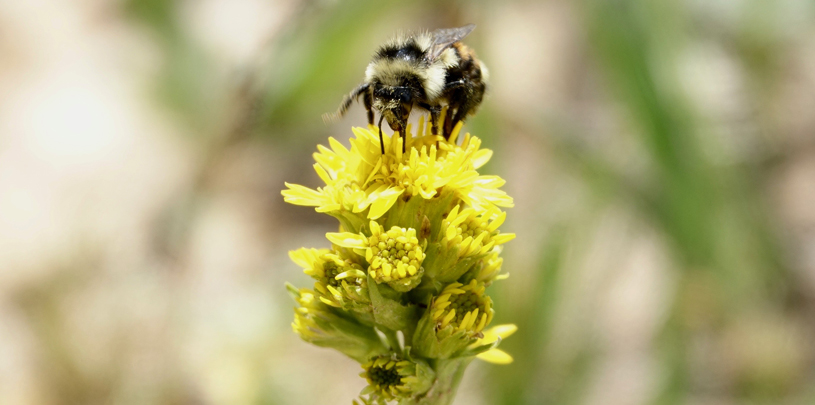
 Guest blog by Thomas Meinzen, former Utah Forests Fellow
Guest blog by Thomas Meinzen, former Utah Forests Fellow
Visit any of Utah, Arizona, or Colorado’s national forests in the summertime and you’ll find a dazzling variety of wildflowers, from delicate sego lilies and columbine to bold spikes of fireweed, lupine, and larkspur.
Look closer, however, and you can peek into a world of biodiversity perhaps even more staggering than the wildflowers: the Colorado Plateau’s native bees. In a single flower patch, you may find iridescent blue mason bees, millimeters-long Perdita bees, long-horned bees with amazing antennae, big, furry bumblebees and, perhaps, even bee species still undescribed by science.
Utah and Arizona are each home to over 1,000 species of native bees — more than all the states east of the Mississippi combined. These bees are indispensable: As highly efficient pollinators, they help produce the next generation of dazzling wildflowers and maintain our forests’ biodiversity.
Unfortunately, the region’s bees are in trouble.
Here on the plateau’s public lands, native bees face a slew of familiar threats, including drought, climate change, and overgrazing. However, they also face a threat that few might expect: honeybees.
Although the Utah state flag and highway signs feature a honeybee hive — a symbol of industry and cooperation — honeybees are actually a non-native species in the Southwest, introduced from Europe by settlers. Unlike North America’s native bees, which are solitary or live in small colonies, honeybees live in huge hives of tens of thousands of bees. This allows thousands of workers to exploit patches of nectar-rich flowers. In such numbers, honeybees handily outcompete native bees for limited pollen and nectar, which all bees need to survive.
I witnessed this displacement firsthand while out hiking in southern Utah last summer. In a canyon near Grand Staircase-Escalante National Monument, miles from where a few honeybee hives were located, I noticed that the area’s rich diversity of native bees (660 species in the monument alone!) had been all but replaced. Everywhere I looked, I saw only European honeybees. Where had the native bees gone?
Most native bees are not long-distance travelers. When honeybees take over the flowers in their area, native bees that can’t find enough nectar and pollen are likely to starve. Scientists have shown that native bees living in proximity to honeybees have lower body weight, are able to raise fewer young, and struggle to collect enough food.
Native bees are also susceptible to many diseases that can be transmitted from honeybees, including diseases like deformed-wing virus that can render both honeybees and native bumblebees flightless. And disease transmission is a two-way street — native bees may also infect honeybee hives with dangerous new diseases.
With these impacts in mind, I was shocked to learn that some Forest Service and Bureau of Land Management (BLM) managers are permitting hundreds or thousands of commercial honeybee hives on your public lands — without ever analyzing their potential effects. Although commercial honeybee permits (“apiary” permits) are given out on public land across the West, the greatest threat may be in Utah, where the continent’s beekeeping giant, Adee Honey (headquartered in South Dakota), has pending permit requests to place over 10,000 hives across four of Utah’s national forests.
Many land managers are (understandably) unaware of the dangers honeybees pose to native bees, while others feel one-sided pressure to allow beekeepers to use public lands. As a pollinator fellow with the Grand Canyon Trust, I have been working to change that. Mary O’Brien, Utah Forests Program director, and I have been contacting land managers across Utah to tell them about this issue and urge them not to permit commercial honeybee apiaries on their districts.
But our voices are not enough! We need your help. As people who value the plateau’s biodiverse public lands, you can help native bees by voicing your concern about this issue to your local Forest Service district ranger or BLM field manager. Since local land managers decide whether to grant or deny apiary permits on their land, you have the chance to help protect the native bees in your area with a quick email or phone call.
You have the opportunity to comment on how you think some of the most beautiful landscapes in Utah should be managed for the next generation to come.
Read MoreTree ring data helps scientists and land managers protect old-growth pinyon and juniper trees.
Read MorePack your camera and head for the trees! The Colorado Plateau has some of the best displays of fall foliage all season long.
Read More